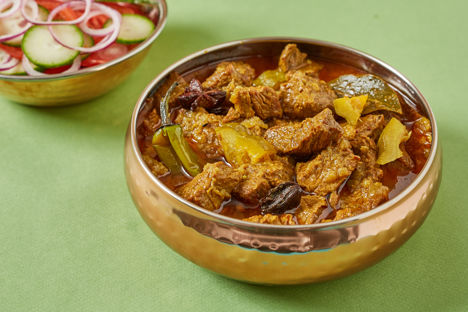
Ingredient focus: Shatkora
Shatkora (or hatkhora) is a yellow-green citrus most commonly associated with the cooking of Sylhet in Bangladesh, where many British Bangladeshis have their roots. Read on to learn more about this special, sour citrus.
Ingredient focus: Shatkora
Shatkora (or hatkhora) is a yellow-green citrus most commonly associated with the cooking of Sylhet in Bangladesh, where many British Bangladeshis have their roots. Read on to learn more about this special, sour citrus.
While many citrus fruits have had their moment in the sun – yuzu has rapidly become a beloved ingredient in restaurants around the world, and blood oranges are made a fuss of every year – shatkora is still relatively under the radar. And although it’s not uncommon to see beef or chicken shatkora on menus, or even the occasional shatkora doner kebab, it’s rare to see the fruit used in other dishes.
Like yuzu, shatkora have a highly distinctive fragrance that sets them apart from other citrus. However, shatkora are much easier to get hold of fresh or frozen than yuzu, and South Asian supermarkets frequently stock shatkora in slices in the freezer section. When in season they can even be found fresh with other citrus.
Unlike oranges, lemons and limes, shatkora have a very thick white pith, and relatively little flesh on the inside. The flesh and juice are very sour – too sour to eat or drink – so the fruit is used more for its rind than its flesh. While most citrus recipes will tell you to take care to avoid the bitter white pith, and only use the zest, with shatkora the whole skin can be used. The thick, fragrant pith can be stewed, either raw or after having been blanched, with meat, vegetables or lentils. The fragrant oils from the zest will infuse sauces with a sharp, citrusy fragrance as the skin softens.
Although shatkora is associated with Bangladeshi food more broadly, it comes specifically from around Sylhet, the name for a region of and city in Bangladesh, where many British Bangladeshis have their roots. In fact, despite the fact that the vast majority (over 85%) of Indian restaurants in the UK are run by Bangladeshis, shatkora-based dishes are one of the few Bangladeshi or Sylheti foods that have become a mainstay on Indian restaurant menus. Shatkora beef is a popular dish both in Sylhet and in British-Indian restaurants, and is sometimes known as ‘Sylheti beef’. Shatkora doner on the other hand is, perhaps unsurprisingly, a more recent British-Bangladeshi invention. Made by braising meat for a doner kebab with spiced onions infused with fresh or pickled shatkora, although not a tradition in Bangladesh, it’s a delicious way to try the citrus.
Shatkora is easier to find in the UK as a pickle than in its fresh form, and can be a good way to infuse the flavour of shatkora into dishes if you can’t find the real deal. However, the pickle is also delicious in its own right. Like lime pickle, it’s made with a spiced oil, vinegar and some salt, and can be used either as a condiment or as the base of a sauce. The pieces of shatkora are often left large, and can be infused into the sauce whole or broken up into smaller pieces.
If you can’t find fresh shatkora, grapefruit is sometimes suggested as a substitute. But although it has a similarly thick pith, grapefruit doesn’t have a shatkora’s fragrance or sourness, and shatkora pickle might be a better option.
If you want to try cooking with shatkora at home, check out our recipe for beef shatkora by Dina Begum – delicious paired with a Bangladeshi dal or fish curry, or simply enjoy some shatkora pickle with your rice or naan.


